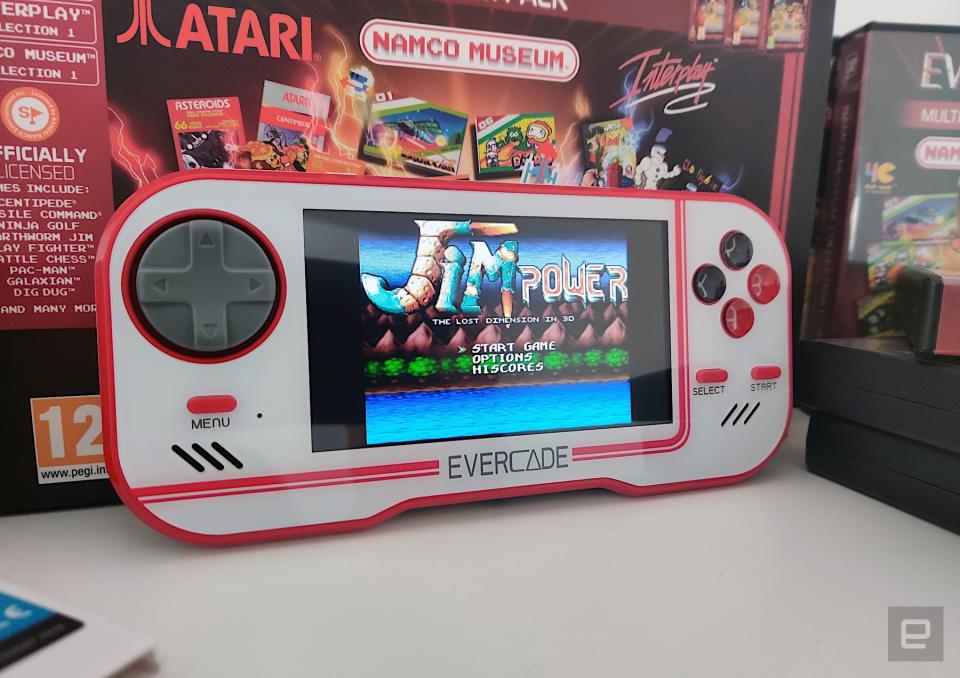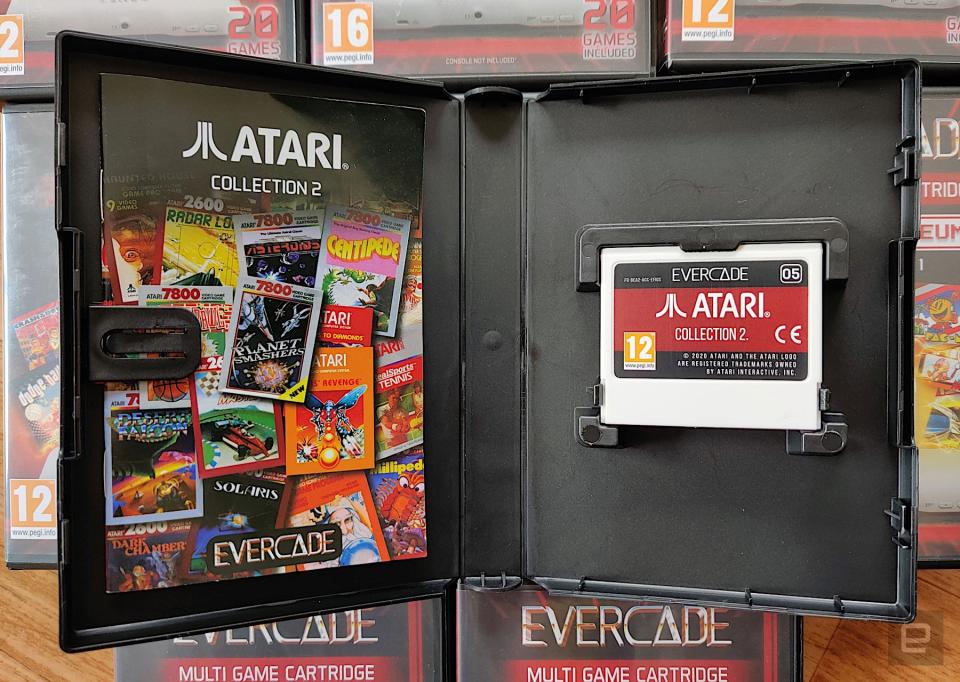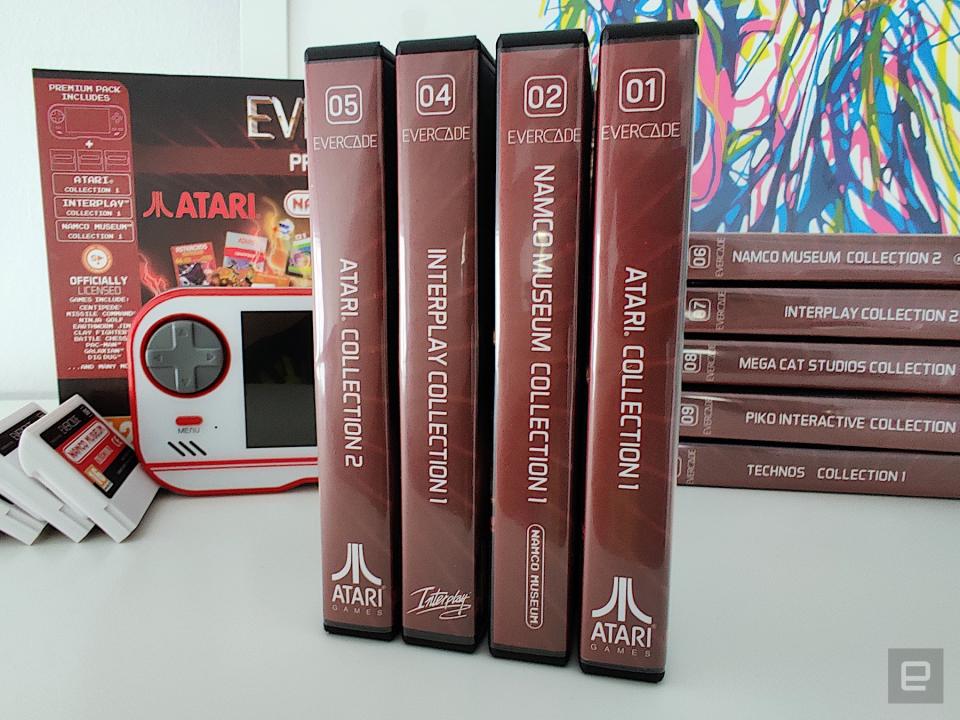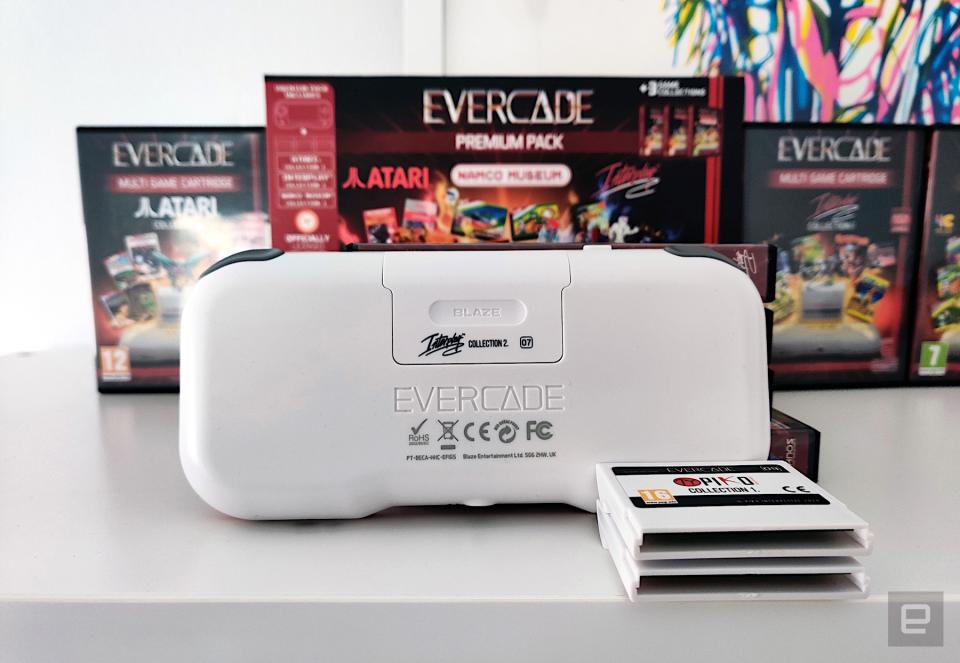Evercade’s cartridge-based retro handheld makes more sense than you think
This one's for the collectors.
Retro gaming has arguably existed ever since there was a second generation of consoles. Today’s gamer seeking a shot of nostalgia has almost as many ways to play vintage titles as there are platforms to collect for. Evercade adds one more to that list. But this time there’s a twist: this one uses proprietary cartridges. This means you’ll need to “collect” the games you want, pay actual money for them and think about which ones you want to bring with you on that flight. There’s no WiFi or online store or SD card to add your own titles. It’s a fresh take on doing things the old way, one that rewards the game developers while delivering an extra authentic experience. But in a world where you can play all these games for free (even if that’s not entirely legit) can it succeed? I hope so, and there are a few reasons why.
First of all, it’s worth taking a look at the current retro gaming landscape. The simplest way to access most old games is through an online emulator. You don’t even need to download any software, simply play in the browser. This is ethically shady at best, unline the full-licensed (and thus legal) Evercade. Then there are the “classic” or “mini” consoles. These up the ante in terms of nostalgia — if a lilliputian NES is your thing. They also provide a legitimate way to play the games, but the selection is usually limited and you’ll need to buy one for each platform you want to revisit. You can also buy a number of handhelds that come preloaded with games. Many of these are unofficial, and the build quality can leave a lot to be desired.
Then there are the open-source/DIY options. Your PC or Mac can probably run every emulator under the sun, but so can the Raspberry Pi, which has a version of most emulation software specifically built for it. From there, you can make your own “classic” console or handheld that will play pretty much anything. Again, playing games this way is legally shady and usually requires a fair bit of setup. Lastly, there are the designer consoles that play cartridges often from multiple systems, either through pre-installed emulators or modern hardware that’s compatible with original cartridges or CDs. These offer a more refined, legal experience, but you’ll need the original games to play on them (though there are often ways around that if you’re so inclined).

Evercade borrows a bit from all the above. It’s modern hardware, which means you’ll enjoy a bright, 4.3-inch display (480 x 272 — easily enough for most 16-bit systems), around 4.5 hours of battery life and a mini HDMI port so you can play on the big screen. Eagle-eyed retro fans might have noted this is similar to the PSP, although the Evercade feels ever so slightly bigger. The proprietary cartridges each hold a collection of games, usually organized by publisher (Atari, Namco and so on). At launch the Evercade will cost $80 (£60) with one pack-in cartridge and $100 (£80) for the premium pack (three included cartridges). Individual game collections will cost $20 (£15) each.
The use of cartridges here is probably the most divisive issue. For some, it adds to the purity of the retro feel. It also means games load instantly (unlike some emulators) and that the titles can be optimized for the system as the emulator for each game is actually held on the cart, not the handheld. There’s also an important secondary benefit, it enables the license holders to be paid more fairly and for the device itself to cost less (more on why later). For many, it’ll be an anachronism too far that adds needless inconvenience. Evercade is not aimed at those people.
The quest for retro authenticity extends to the Evercade’s aesthetics. The white design with vintage “go faster” stripes means the handheld legitimately looks like something you’d find in your parents’ loft. The packaging for both the console and the games also have a distinctly ‘80s feel. Personally, I can’t decide if the Evercade looks retro-cool, or like a generic handheld you’d find on Amazon. I switch between both depending on my mood, but it’s well-built and looks the part.
At launch, 10 collections will be available from the likes of retro stalwarts like Atari, Technos, Data East and Interplay. There will also be cartridges from newer companies that specialize in licensing retro games, notably Piko Interactive and Songbird productions. The result is a fairly eclectic library of around 120 titles so far, with more to come.

One thing’s clear from looking at the list of games: This isn’t a greatest hits collection of the usual big names. There’s no Sonic or Mario (for obvious reasons), though there are classics such as Pac-Man, Earthworm Jim and Burger Time. Many of the titles you may have never heard of, but everything has been curated and handpicked, rather than just scooping up as much IP as they could. The team turned down plenty of titles they didn’t think would be a good fit. “We've gone for quality over quantity, in our view. We don't want to be a console that has 3,000 games.” Andrew Byatt, Director of Product Development, told Engadget.
I’ve spent some time with the first round of releases, and there’s a lot there. Too many to talk about individually, but the CliffsNotes are that RPG fans will want to scour the releases closely, as the options are limited, and mostly on one cartridge. There’s Canon: Legend of the New Gods — a Chinese Fire Emblem-like release on the Genesis, and Brave Battle Saga, an obscure, but fun, Taiwanese release. But if you want to scratch that Chrono Trigger itch, they’ll do the job just fine. There’s also Drakkhen, ported from the SNES, which is a 3D take on the genre along with a few others.
If you’re into fighting games and beat-em-ups though, a mainstay of the ‘90s era, you’re in luck. There’s Clay Fighters 1 & 2, Two Crude Dudes, Bad Dudes (no relation), Renegade and three different Double Dragon titles among many others. Everything else is represented more evenly, with plenty of puzzlers, platformers, adventure games, sports simulators and vintage arcade button mashers.
The selection of titles so far is as much a reflection of the perils of licensing as it is anything else. Many games are either locked into other platforms, have unknown rights holders or it’s just not possible to prove who “owns” them. As Byatt explained “[the developers] don't have the appropriate legal documentation to deliver that game to you. But literally, no one else does, either.” Paperwork, lost to the sands of time, leaving the games in legal homeostasis.
Fortunately, with such a vast library of games available to plunder, there are enough hidden gems and rarities to keep something like the Evercade going for a long time. It’s technically capable of emulating games up to around the original PlayStation era, but right now the focus is mostly on 8- and 16-bit consoles.

As for why the cartridge system helps, it basically makes it a lot easier to compensate each developer fairly. If their collection sells, they get paid each time. If the device had come with games preloaded, the console would have cost a lot more, and then there’s the headache of determining how much of each console sale each game gets.
Of course, the cartridges are about more than simplified economics. For retro fans it’s a direct connection to the good old days: Popping open a new game, holding something physical that you can display. Evercade even devilishly numbered each release which will pique the collectors itch in those afflicted with it. One of the titles was missing in the pack they sent over and seeing the boxes lined up: 1, 2, 4, 5 was surprisingly annoying.
If you don’t have the compulsive urge to buy them all, it’s worth knowing that some releases offer better value than others. For example, the number of titles per cartridge can vary quite a lot. The lowest amount of titles on one cartridge so far is six games, often in a similar genre, while others offer 20 with more variety. The Piko collection in particular offers good variety and total playtime.
The last piece of the puzzle is that Evercade offers another outlet for new titles developed for retro platforms. Convincing someone to spend upwards of $40 for a “new” Genesis game is a hard sell beyond the avid collectors. But for $20, you can snag Mega Cat’s collection of new titles, which are surprisingly good, and could easily have been rare titles from the past if you didn’t know.
The big question is: will people get it? Byatt obviously hopes so. “If you have 3,000 games on a console, which is, you know, if not legal, it's easy to achieve, you don't know which one to play, and they don't seem to have much value to you.” With Evercade, the idea is that you can add to the library over time. “We liked the idea of something that continues beyond your initial purchase.”
And, of course, really it always comes back to that pure experience. “We used to love that experience of cracking open a cartridge and the whole experience like there's a little manual etcetera, I just don't think you get that with downloads.”

Evercade might be dialing up the nostalgia, but there are some concessions. The HDMI output is an obvious one, but there are a few others hiding in that vintage (but modern) handheld. Save states can also be found under the menu for each game, something barely even possible back in the day unless you added a battery to the game (which will long since have died) or jotted a bunch of codes down on a scrap of paper. But otherwise that’s it.
One important thing to note: the option for two players is present in all the games that support it, but there’s no way to use it. Byatt says this is on purpose. “Plugging multiple controllers into a small handheld... it doesn't feel very clean and doesn't feel like a nice experience.” So why is it there? “For whatever hardware we create in the future, we're going to look to support the cartridges you buy today.” So it’s fair to say Evercade might release other retro consoles in the future, perhaps for the living room, that play the same media as this handheld.
The one last thing you might be wondering, is if there’s a way to convert the Evercade into a ROM player, perhaps with an SD card? The short answer is… it’s technically possible but would take some tinkering. But Byatt doesn’t see it as a threat “As it stands at the moment, you know, there's so many devices that do that already. So why would you bother?”
Is it a novelty? Yes. Is it fun? Also yes. I was expecting to be a bit disappointed after seeing some of the titles (or rather, lack of ones I knew). But the collections really do offer some surprising gems (and a few duffs, but everyone’s tastes are different). I’m a retro game collector, so I naturally get it, for those that don’t, there are plenty of alternatives. Evercade goes up for pre-order on Amazon in the US April 5th, or right now on funstock.co.uk. Europeans will also be able to pick one up in select stores (Argos, Game and Fnac for example) when it ships on May 22nd.

